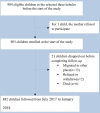Incidence and risk factors of common infections among children in Wonago, southern Ethiopia: a prospective cohort study
- PMID: 39317513
- PMCID: PMC11423750
- DOI: 10.1136/bmjopen-2024-084931
Incidence and risk factors of common infections among children in Wonago, southern Ethiopia: a prospective cohort study
Abstract
Objective: There are limited data in Ethiopia on common childhood illnesses. We aimed to measure the incidence and risk factors of common childhood illnesses in rural parts of southern Ethiopia.
Design: A community-based cohort study.
Participants and study setting: A total of 903 children of 5 years or younger were included between July 2017 and January 2018. We randomly selected households from three administrative units (kebeles) in Wonago district in Ethiopia.
Outcomes: Data on incidence of illnesses were collected by interviewing the mothers of the children every second week, in 6 months. Incidence densities per child-week of observation were calculated, and predictors or recurrent illnesses were evaluated in multilevel Poisson regression models.
Results: Out of 903 children, 882 were included (97.6%). At least one illness was experienced among 87.3% of the children. Overall illness incidence rate was 19.7 episodes per 100 child-weeks, 95% CI 18.4 to 20.7. The incidence rate of fever symptoms was 5.5 episodes per 100 child-weeks; of acute respiratory infections (ARIs) 4.2 episodes per 100 child-weeks; of diarrhoea, 3.4 episodes per 100 child-weeks. In the multilevel analysis, household wealth status, child age, child nutritional status, source of drinking water, place for cooking and number of children below 5 years of age in the household were main risk factors for illnesses.
Conclusions: Children below 5 years of age in Ethiopia often experience fever, ARIs and diarrhoea. The identified risk factors were related to poverty and highlighted the importance of preventive measures to reduce the incidence of these diseases.
Keywords: community child health; epidemiology; follow-up studies; infectious diseases; respiratory infections.
© Author(s) (or their employer(s)) 2024. Re-use permitted under CC BY-NC. No commercial re-use. See rights and permissions. Published by BMJ.
Conflict of interest statement
Competing interests: None declared.
Figures


Similar articles
-
A one-year community study of under-fives in rural Ethiopia: patterns of morbidity and public health risk factors.Public Health. 1995 Mar;109(2):99-109. doi: 10.1016/s0033-3506(05)80003-4. Public Health. 1995. PMID: 7716257
-
Geographical variation of common childhood illness and its associated factors among under-five children in Ethiopia: spatial and multilevel analysis.Sci Rep. 2023 Jan 17;13(1):868. doi: 10.1038/s41598-023-27728-8. Sci Rep. 2023. PMID: 36650192 Free PMC article.
-
Trends of inequities in healthcare seeking behavior for diarrhea, fever, and ARI symptoms among women in reproductive age groups for their under-five children in Ethiopian: A multilevel Analysis of EDHS Surveys from 2000 to 2016.PLoS One. 2025 Apr 1;20(4):e0318651. doi: 10.1371/journal.pone.0318651. eCollection 2025. PLoS One. 2025. PMID: 40168256 Free PMC article.
-
Effect of household water treatment with chlorine on diarrhea among children under the age of five years in rural areas of Dire Dawa, eastern Ethiopia: a cluster randomized controlled trial.Infect Dis Poverty. 2020 Jun 8;9(1):64. doi: 10.1186/s40249-020-00680-9. Infect Dis Poverty. 2020. PMID: 32513277 Free PMC article. Clinical Trial.
-
Financial risk of seeking maternal and neonatal healthcare in southern Ethiopia: a cohort study of rural households.Int J Equity Health. 2020 May 18;19(1):69. doi: 10.1186/s12939-020-01183-7. Int J Equity Health. 2020. PMID: 32423409 Free PMC article.
Cited by
-
Prevalence of ARI, fever, and diarrhea among under-five children and the influencing factors in southwestern coastal region of Bangladesh.BMC Public Health. 2025 Aug 27;25(1):2951. doi: 10.1186/s12889-025-24415-3. BMC Public Health. 2025. PMID: 40866902 Free PMC article.
References
-
- Central Statistical Agency (CSA) [Ethiopia] and ICF . Ethiopia demographic and health survey 2016: key indicators report. 2016, CSA and ICF: Addis Ababa. Ethiopia, and Rockville, Maryland, USA:
-
- United Nations United Nation 2017: The Sustainable Development Goals Report 2017. New York. 2017.
-
- United Nations . United Nations (UN) 2015: Sustainable Development Goals (SDG3) United Nations 2015. Brazil; 2015.
-
- World Health Organization . World Health Organization (WHO) 2019: key facts of pneumonia. World Health Organization: Geneva Switherland; 2019.
Publication types
MeSH terms
LinkOut - more resources
Full Text Sources
Medical
